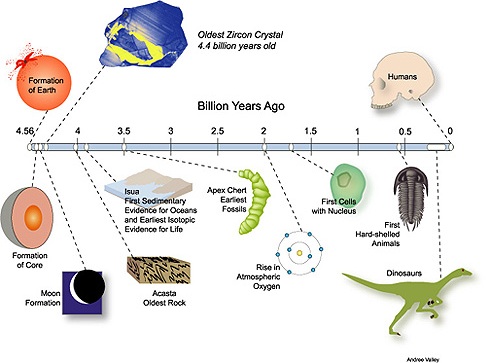Summary on history of the Earth
- Formation of the Earth: The huge clouds of gas which were part of the solar nebula have combined into solid particles of matter before 4.6 billion years. There were so many of these particles of matter that they were pulled toward each other by the force of gravity. These particles formed into large blobs of matter which formed planets in our solar system and their moons. The surface of Earth is extremely hot, covered with molten lava lakes. The surface of the Earth was constantly being hit by objects from space, called comets and planetesimals.
- Formation of the Moon: Inseparable part of Earth’s long history has formed out of the debris left over from an indirect collision between Earth and an astronomical body the size of Mars, approximately 4.5 billion years ago.
- At about 4.1 billions years ago the surface of the Earth was still very warm, but some parts of it cooled down enough for water vapor to condense and form liquid water. Rain fell from the sky for millions of years and covered most of the Earth with oceans. Energy from the sun and from lightning produced chemical reactions in the air that formed very complex molecules like nucleotides and amino acids. These are the building blocks of DNA. There began the process of preparation of all necessary for creation of life.
- The origin of life can be dated to about 3.5 billions years ago where the microspheres eventually evolved into very simple cells. The earliest fossils found were formed at this time. This time is linked to the evolution of bacteria.
- About one billion year later the photosynthesis (life’s ability to absorb sunlight and use the energy from it to make food from the carbon dioxide in the atmosphere) evolved. The oceans very quickly filled up with bacteria that could perform photosynthesis. One of the waste products of photosynthesis is oxygen. This is when the atmosphere first started to fill up with oxygen.
- Enough oxygen caused that organisms evolved to use it as an important resource in the time of about half a billion year later. This helps them convert food into energy by process called respiration.
- After another more than one billion year the first known multi-celled eukaryotic animal fossils formed.
- At about 0.6 billion year ago happened “Cambrian explosion” in which a lot of types of invertebrate animals evolved in the oceans. Oxygen in the atmosphere reached 2 percent at this point. 100 millions years later we can find first fishes.
- Later on the sufficient layer of ozone was formed in the upper atmosphere and began to blocks the dangerous ultraviolet rays of the sun, though allowed to form a life on land. Oxygen is at 20 %. A bit later first plants (as today’s mosses) evolved.
- 300 millions years ago was the age of fishes – in oceans a variety of fishes evolved. As well in this time first insects appeared.
- 200 millions yars ago the first reptiles evolved, and by the end of this period, dinosaurs had evolved. There were warm humid conditions that resulted in huge forests of primitive land plants, which later formed the deposits of coal.
- Later on mammal-like reptiles evolved, oxygen in the atmosphere reached the level that it as at today. The continents that made up Pangea started moving apart.
- The 100 millions years ago was the age of dinosaurs. The first flowering plants evolved and as well with the first mammals, birds evolved from small tyrannosaur-like dinosaurs. A bit later flowering plants became very abundant on land. With the extinction of dinosaurs about 65 millions years ago, mammals became very abundant in land environments.
- At the very end of this period – about 3 million years ago the first human-like mammals evolved. Then, at about 50,000 years ago, the first real humans evolved known as Homo sapiens.

